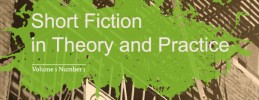
photo by Martin Howard
by Loree Westron
In a recent THRESHOLDS article, Lynda Nash commented about the need for students to understand that redrafting is an essential part of the writing process and that none of us get our stories down on paper as we wish to see them the first time around. In my experience, students often view the beginning stages of story writing as the most exciting. Inspiration and those early sparks of creativity offer boundless opportunities for the creation of something new, something original and self-expressive, and first drafts can be a great adventure in which many surprising discoveries are made. Redrafting on the other hand is far less glamorous, and is frequently approached as a chore rather than a pleasure.
I try to encourage students to treat the first draft as a kind of reconnaissance mission in which the main purpose is to check out the terrain and learn about their characters. To me, first drafts are all about gathering information and experimenting with an idea. Often it’s only after the third or fourth draft that the real story begins to emerge.
I believe that story writing is a craft which requires patience, perseverance and faith, and was therefore curious about David Vann’s comments about redrafting during his March 2011 Q&A session with THRESHOLDS. When asked about his own process Vann stated: ‘my final drafts are almost identical to my first drafts. “Ichthyology” had one paragraph cut and one added. Caribou Island had only a few paragraphs of background info added, and line edits. I was always told writing is mostly revision, but for me, the work lives or dies in the first draft.’ Vann also teaches Creative Writing, and I’m sure he’s very much aware of the impact those words will have on student writers. I wish now that I had asked him to elaborate on his process because I’m certain there’s much more taking place during the construction of his ‘first drafts’ than he let on.
Many writers would disagree with Vann’s views on drafting. Ernest Hemingway famously claimed that ‘all first drafts are shit’. Raymond Carver, arguably the most successful short story writer of the 20th century, is said to have completed 20-30 drafts before handing his stories over to Gordon Lish. And Alice Munro claims to do as many as 80 drafts before she’s satisfied enough to let the story go. The consensus is that redrafting is not to be ignored.
I wonder, though, if our definition of ‘drafts’ has changed since the advent of the personal computer. In the old days, when I started writing, a draft was produced on a typewriter. You pulled it out of the roller at the back of the machine and annotated the pages by hand. Then the whole thing was retyped from scratch to produce the next draft. Now, however, many writers write, redraft and edit before they ever produce a hardcopy of their story, and rather than saving all the changes as individual documents, simply overwrite the previous version and press ‘Save’. In my own process, I tinker incessantly with syntax and descriptions and dialogue, and I may go over a single paragraph twenty times before moving on to the next. Finally, when I’m done, I’ll print the story and call it ‘Draft One’ – even though it’s already gone through a substantial amount of re-writing.
I find that I need these paper drafts in order to fully see the structure of my stories (often laying the pages out on the floor so that I can see everything at once). If the structure needs work, I cut and paste the old-fashioned way, physically moving the pieces around until I’m reasonably happy that the new structure works. Then it’s back to the computer screen to put the changes into effect, followed by further tinkering with syntax, description, dialogue, and now links, before printing out ‘Draft Two’.
Students might point to Vann’s apparent dismissal of the need for redrafting as justification for their own resistance to re-working their stories, just as they currently point to Cormac McCarthy’s idiosyncratic use of punctuation to justify their lack of commas and apostrophes. I’m convinced, however, that Vann does carefully redraft his work, by one method or another.
Vann began writing Legend of a Suicide when he was nineteen years old, nearly a decade after his father’s death, and finished ten years later. He will, no doubt, have spent much of his childhood constructing stories to explain this traumatic event and it seems likely that this process continued once he began putting pen to paper. The drafting and redrafting may simply have taken place internally, allowing the stories to emerge fully-formed.
How then to explain Caribou Island which took a mere five months to write? There is a question I will continue to ponder as I encourage my students to redraft their work.


Thanks Vanessa. Can’t wait to read it. I hope others are enjoying this conversation as well.
Readers of Thresholds may be interested to read the extensive debate about redrafting and sharing of redrafting processes, by many well-published short story writers – that took place recently on Tania Hershman’s blog. The debate began when Tania (herself highly experienced – she is teaching an Arvon course on short fiction writing as we speak) – discovered she had ruined a short story by over-editing. She threw out the question – how do we know when to stop? What are the processes you use? The responses are most interesting, and serve to illustrate the impossibility of pinning anything in this writing stuff down to a single ‘thou shalt’. The links are here: http://titaniawrites.blogspot.com/2011/03/revising-short-stories-science-or-art.html
http://titaniawrites.blogspot.com/2011/04/revising-discussion-part-ii.html
http://titaniawrites.blogspot.com/2011/04/revising-short-stories-part-iib.html
I was amused to see in the final discussion, a quote from American writer Robert Heinlein (I think – forgive the spelling if its wrong) – the central ‘rule’ in his five rules for writers, is ‘Never edit anything, unless requested by an editor. I paraphrase. What utter madness! First find your editor, I say, and most of us stand no chance of that without a clean manuscript.
And echo – this is such an important topic – good to air it! Thanks Loree.
Thanks for the links, Vanessa. It’s an important topic, and one which sometimes gets sidelined. Going back to my original point, interviews with well-known writers often focus on sources of inspiration because there seems to be a ‘magical’ element to that moment when a story emerges. But we can see here that redrafting is something we’re all very concerned about – when to do it, and just as importantly when to stop. Perhaps over-editing would be a good topic for a blog post. You interested in doing this one, Vanessa?
I am certainly happy to give it a go! It is, as you say, a knotty subject. In the end, aren’t we all working towards that state of being where we can look at a piece of our own writing and know it is ‘cooked just right’? I guess sometimes, that means many stages of radical changes, taking a long time. But it can also mean a close comb through – and changing very very little. How do we know when to stop…I’m on the case!
I understand what David Vann is saying. And that is not to undermine the wisdom of encouraging writers to go through everything with a fine tooth comb (to check for cliches such as that one, for starters…) to ensure that the final article is exactly, but exactly, what they will be most proud of. I do think we all have different processes, and more than that, maybe each piece of work needs different skills as well. I know that I have very often needed to redraft a short story many many times, taking months if not years in a couple of cases to reach the end of the process and a story that I know is ‘done’. But equally, there were some stories that appeared almost ‘right’ as they were born. Not often enough, I hasten to add. And those tended to be very short – stories that appeared in flash writing sessions, where I was deliberately following prompts, and each sentence surprised me because it was unplanned. I’m sure David Vann was not intending to give bad advice. He was just being honest – and that is sometimes hard to accept when it goes against the norm.
Hi Vanessa,
You’re quite right – we do all have different processes, and with experience and experimentation we come to know what works best for us. And indeed! There are those marvellous gems – those stories that seem to emerge fully formed as if planted in our brains by a truly benevolent creator (if only they happened more often…)! But I’m sure I’m not the only one who is envious of David Vann’s ability to write what I think is truly incredible prose in a ‘single’ draft. I’m equally certain, though, that none of us would wish to trade places with him.
And I’m by no means implying that David was giving bad advice. I doubt that he advises his own students not to redraft their work – though perhaps he is less prescriptive about how they redraft (at a previous university where I taught, students were required to submit their drafts along with their final work, as evidence that they had ‘gone through the process’). In the vast majority of cases, though, students do benefit from redrafting. I certainly have. It’s a way, I think, of instilling a sense of discipline in oneself, emphasising the need to attend to details, and taking pride in one’s work. Perhaps, though, not enough attention is given to helping students recognise when something really is ‘finished’.
Vanessa I too have found, in my limited experience, that some stories seem to write themselves, This is what happened with my most successful story thus far. After struggling for so long, one day this story came to me and it was written: the voice, the plot, the imagery it all came together. I posted this on my blog in response to one of you posts (link is below). Even so, there was still much rewriting and redrafting that I needed to do. It took a couple of months, or maybe a year, that I worked on it here and there until one day I sensed that I had something. I still mistrusted it though. It wasn’t until someone else read it who said i should try to get it published that I started getting some confidence. Eventually I felt I said everything I needed to say and that it was “quality” work, something anyone would be proud of. I will say that the difference between this one story and the others which haven’t been as successful, seems to be the purity of vision. I knew exactly what I wanted to say. There was no hesitation or second guessing on the plot or images. Everyone is different and I can’t speak for everyone else but is this the common denominator?
It’s now 9:42 and I still haven’t done a thing but I’m enjoying this conversation. Thanks!
The link if I may: http://doradeecee.blogspot.com/2011/04/who-are-we-as-writers-and-5-rules-for.html
Loree I used to think that my stories would write themselves, that if I were truly a “writer” there would be no reason for me to stumble over words or stubborn characters that refuse to follow my lead but go wherever they fancied, leaving me in the lurch, but now I know better. First I think a writer has to believe in themselves, in their characters and in what they are trying to say. If they don’t, or if their way is full of shadows or other impediments, then nothing will flow from their pens or fingertips (I’m typing on my notebook!). Perhaps this is what David Vann was alluding to: if you’ve managed to break through your fears, then nothing can stop you from writing what you were meant to write. No amount of redrafting will help if inside there’s a part ready to sabotage your efforts. The funny thing is that I too have mulled a story for over 30 years (much longer than David Vann), but now I am ready to bring it to life. Where I used to struggle over characters, setting, etc. now I find it flows. As far as drafts…well let’s just say I have kept all of the copies of my earlier stories. Today, I don’t necessarily print everything but when I feel that a story is going in another direction, then I will create another version. Eventually I find I will cut and paste from one to the other. Mind you my work has just begun; I haven’t had anything published yet but I feel I’m very close. I think my story is different; I’ve struggled through many setbacks and it has taken me this long to arrive at a point where I can admit to myself that I am a writer. I do not wish my journey on anyone and I hope that everyone who reads this is having a much easier time in accepting and honoring their gift. Now that I’ve “arrived,” redrafting my stories brings many wonderful opportunities to make my world come alive. The problem is to strike a balance between telling and showing and when I am open to my imagination, the perfect solution presents itself.
I would love to hear from others as well! Thanks Loree
Confidence is, I think, one of the major keys to being a ‘writer’. We all feel like we have something worthwhile to say – that’s why we put pen to paper in the first place. Self-belief is essential. But so too is that inner critic that keeps insisting we go over our work – questioning it, developing it and polishing it into something magical.
Dora, I look forward to seeing your work in print very soon. And when that time comes, you have a platform at THRESHOLDS to blow your horn!
Thank you Loree. You will definitely be the first to know! Tomorrow by 11:59pm I am hoping to have two complete short stories done for yet another contest: one a literary short story for about 4,000 words and the other a children’s story for 2,500 words. I had promised myself I wouldn’t enter anymore contests — since winning the honorable mention which gave me a much needed confidence boost — I had entered four contests without success. In the meantime I’ve been working on my novel and I did post an excerpt in a critique group which was very well received. In fact, someone suggested that rewrite some scenes and submit them as short stories. I’m not sure if I’ll make it. It’s already 9:20 pm and I haven’t done a thing! I’m hoping my subconscious will take over and give me what I need. Speaking of redrafting! I have all of my characters, setting, etc., now I have to come up with a structure and conflict suited for two short stories. I will let you know how I do, if I make it.
Good luck Dora, and keep us posted! Good things are going to happen – I feel it in my bones!
Submitting stories to competitions can be a depressing business, I know. I go through phases where I promise myself that I’m going to save the entry fee and submit more work to journals and literary magazines instead. But the competitions are so tempting – and there’s the added kudos of winning a big prize. There’s no denying that it’s hard though, maintaining confidence when your name doesn’t appear on the shortlist. I do think perseverance is the key. If you don’t submit work, you’re definitely not going to win.